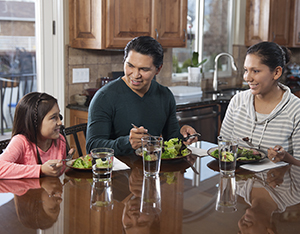When Your Child Has Iron-Deficiency Anemia
In anemia, there is a lower than normal number of red blood cells (RBCs). Or a lower level of hemoglobin (a protein that carries oxygen) in the red blood cells. Anemia can be caused by many conditions. In iron-deficiency anemia, the cause of anemia is not having enough iron in the body. RBCs are important because they help carry oxygen all over the body. If the RBCs or hemoglobin is severely low, the body's cells don't get enough oxygen. Iron-deficiency anemia can affect your child’s growth, brain function, and development if not treated. The healthcare provider will evaluate your child and advise the best type of treatment for iron-deficiency anemia.
What causes iron-deficiency anemia?
-
A low-iron diet
-
A diet that's too rich in cow or goat's milk or dairy products
-
A digestive problem that affects iron absorption
-
Lead poisoning
-
Blood loss, such as from heavy menstrual periods or the gastrointestinal tract (milk protein allergy, colitis, or inflammatory bowel disease)
What are the symptoms of iron-deficiency anemia?
Your child may have no symptoms at all. If symptoms are present, they can include:
-
Pale skin, lips, and hands
-
Low energy and tiredness
-
Pica (the tendency to eat nonfood items, such as ice, chalk, clay, or paper)
-
Poor appetite
-
Frequent infections
-
Shortness of breath (especially with activity)
-
Fast heartbeat and breathing rate
-
Cold hands and feet
-
Dizziness
-
Frequent headaches
-
Slowed growth and development
-
Mental and behavioral effects
How is iron-deficiency anemia diagnosed?
The healthcare provider asks about your child’s symptoms, diet, and health history. A physical exam is also done. Your child will need lab tests, such as a complete blood cell count to confirm there is anemia. Other tests may be done to learn if the anemia is caused by bleeding or low iron levels and to find the reason for low iron levels. The tests will also help diagnose any other causes of anemia, such as vitamin deficiencies, thalassemia, or sickle cell anemia. Usually iron-deficiency anemia is diagnosed by a routine blood count test.
How is iron-deficiency anemia treated?
Treatment choices include:
-
Iron supplements. The healthcare provider may prescribe iron supplements taken by mouth (oral) to increase the iron your child gets. It may take 1 to 3 months for your child’s RBC count to return to normal. Don't give your child iron supplements without a healthcare provider’s supervision. Too much iron can lead to serious health problems in your child. In some cases, iron may need to be given through an IV (intravenous) line.
-
Iron-rich foods. You may need to give your child more foods that are rich in iron. The body tends to absorb iron from meat better than iron from non-meat foods. This includes beef, fish, chicken, turkey, and pork. Non-meat foods that are good sources include iron-fortified pastas, rice, breads or cereals, tofu, peas, lentils, raisins, dried fruits, sweet potatoes, dark green leafy vegetables (broccoli and greens), beans, or peanut butter.
-
Vitamin C. This helps the body absorb iron because it creates an acidic environment in the gastrointestinal tract . This increases iron absorption. Vitamin C can be found in vegetables and fruits, especially citrus fruits.
-
Birth control pills. Bbirth control pills may be prescribed to regulate the menstrual cycle and reduce blood loss if the cause is heavy menstrual flow.
-
Blood transfusions. These may be needed if your child’s RBC count is very low.
How is iron-deficiency anemia prevented?
 |
| To prevent iron-deficiency anemia, add more foods that are rich in iron to your child’s diet. |
Ways to prevent iron-deficiency anemia include:
-
If possible, breastfeed your baby for at least 12 months. Starting at age 6 months, give your baby plain, iron-fortified infant cereal or pureed meat. Just 2 or more servings a day can meet a baby's iron needs at this age.
-
When your baby is about 6 months old, include a feeding per day of foods rich in vitamin C with foods that are rich in iron. This can help improve iron absorption.
-
Make sure your child has a well-balanced diet with foods rich in iron.
-
If your child is formula-fed, ask their healthcare provider to advise you on some iron-rich formulas. These can help with growth and development. Also ask about iron-rich baby foods for when your child is ready to eat solids.
-
Do not give cow's milk to babies younger than 12 months.
Online Medical Reviewer:
Marianne Fraser MSN RN
Online Medical Reviewer:
Shaziya Allarakha MD
Online Medical Reviewer:
Susan K. Dempsey-Walls RN
Date Last Reviewed:
9/1/2024
© 2000-2024 The StayWell Company, LLC. All rights reserved. This information is not intended as a substitute for professional medical care. Always follow your healthcare professional's instructions.